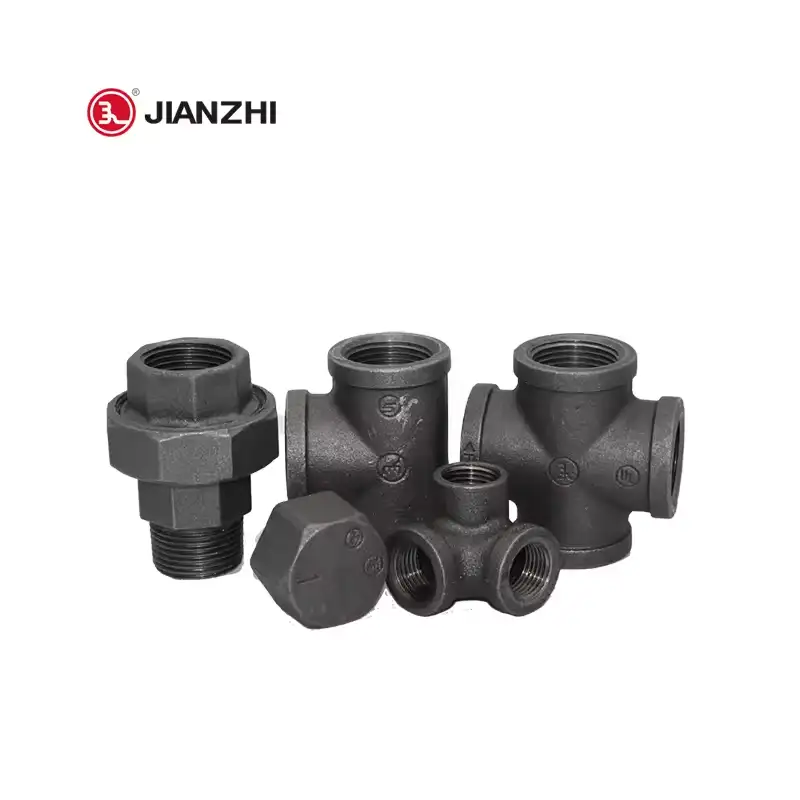Pipe fittings play a vital role in industrial, building, and household piping systems. Any wear or cracks can cause leaks, unstable pressure or equipment damage. Whether it is black pipe fittings or galvanized pipes, regular inspections are a key step to ensure safe operation. This article will share professional inspection methods and applicable scenarios based on industry standards and JIANZHI’s pipe fittings manufacturing experience.
Ⅰ. Why do you need to check for wear and cracks?
Pipe fittings are subject to pressure, temperature changes, and fluid erosion for a long time, and are prone to wear, corrosion, and cracks. For galvanized pipe fittings, although the zinc layer can effectively prevent corrosion, if the surface is damaged, the base iron will accelerate oxidation. Although black pipe fittings have high mechanical strength and wear resistance, they still have hidden dangers under high pressure, vibration, or corrosive media. Regular inspections can not only prevent leakage accidents but also extend the life of the pipeline system.

Ⅱ. Common inspection methods
1. Visual inspection
Check the surface for rust spots, bulges, cracks, or signs of dezincification.
Use a magnifying glass to check whether there are fine cracks in the weld and joints.
For black pipe fittings, focus on observing whether there is wear or thread slip in the thread area.
2. Size and wall thickness detection
Use a caliper, vernier caliper, or ultrasonic thickness gauge to detect changes in wall thickness. If the wall thickness thins by more than the standard value (generally 10%), it needs to be replaced.
Check whether the connecting threads are smooth and complete, especially NPT or BSPT threads.
3. Non-destructive testing (NDT)
Usonic testing (UT): Can detect cracks or corrosion inside the pipe fittings.
Magnetic particle testing (MT): Suitable for surface crack detection of black pipe fittings.
Penetrant testing (PT): For small cracks on the galvanized surface, it is better to use a color developer.
Radiographic testing (RT): Used to check for internal defects in welded joints.
III. Pressure and leak testing
In industrial applications, pipe fittings need to withstand high working pressures. The sealing can be tested by a hydraulic or pneumatic pressure test (usually 1.25 times the working pressure). If bubbles or leakage occur, the pipe should be immediately stopped and replaced.
IV. JIANZHI’s pipe quality and inspection guarantee
As a professional pipe manufacturer, JIANZHI’s galvanised pipes and black pipe fittings are strictly implemented by ISO, ASME, DIN, and other standards. Our galvanized pipe fittings are made of high-quality malleable cast iron, annealed and zinc-dipped, with excellent corrosion resistance and mineral deposition resistance, suitable for various indoor and outdoor environments.
Galvanized pipe fittings: including elbows, tees, sleeves, reducers, plugs, etc., with threads that meet international standards such as NPT and BSPT.
Black pipe fittings: resistant to high pressure and wear, widely used in oil, gas, water, and HVAC systems.
Each batch of products undergoes thread accuracy inspection, wall thickness measurement, sealing tes,t and NDT spot check before leaving the factory to ensure zero defects.
V. How to prevent pipe wear?
Reasonable material selection: For highly corrosive media, galvanized pipe fittings or anti-corrosion coatings can be preferred.
Correct installation: Avoid excessive torque during installation to prevent thread cracking.
Regular maintenance: For systems susceptible to erosion or high temperature, a comprehensive inspection should be carried out at least every 6-12 months.
Anti-electrochemical corrosion: When connecting different metal pipe fittings, dielectric joints should be installed or suitable sealing materials should be used.
VI. Applicable scenarios
Galvanised pipe fittings: Widely used in outdoor pipes, irrigation systems, drinking water, and HVAC pipes, with strong anti-rust ability.
Black pipe fittings: Commonly used in industrial fluid transportation, gas pipelines, and high-pressure steam systems, with high strength and heat resistance.
JIANZHI can provide a full set of pipe fittings catalogs and customized services according to customer needs. If you need to purchase in bulk or learn more about China pipe fittings products, please contact us for the latest quotation and technical support.
Conclusion
Inspecting pipe fittings for wear or cracks is a systematic process that requires a combination of visual inspection, dimensions, NDT, and pressure testing. With high-quality black pipe fittings and galvanised pipes, the safety and durability of the system can be greatly improved. With mature production technology and strict testing procedures, JIANZHI provides stable and reliable pipe fitting solutions for global customers.
